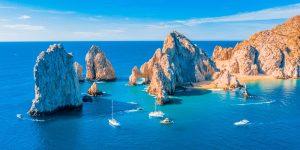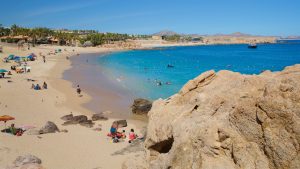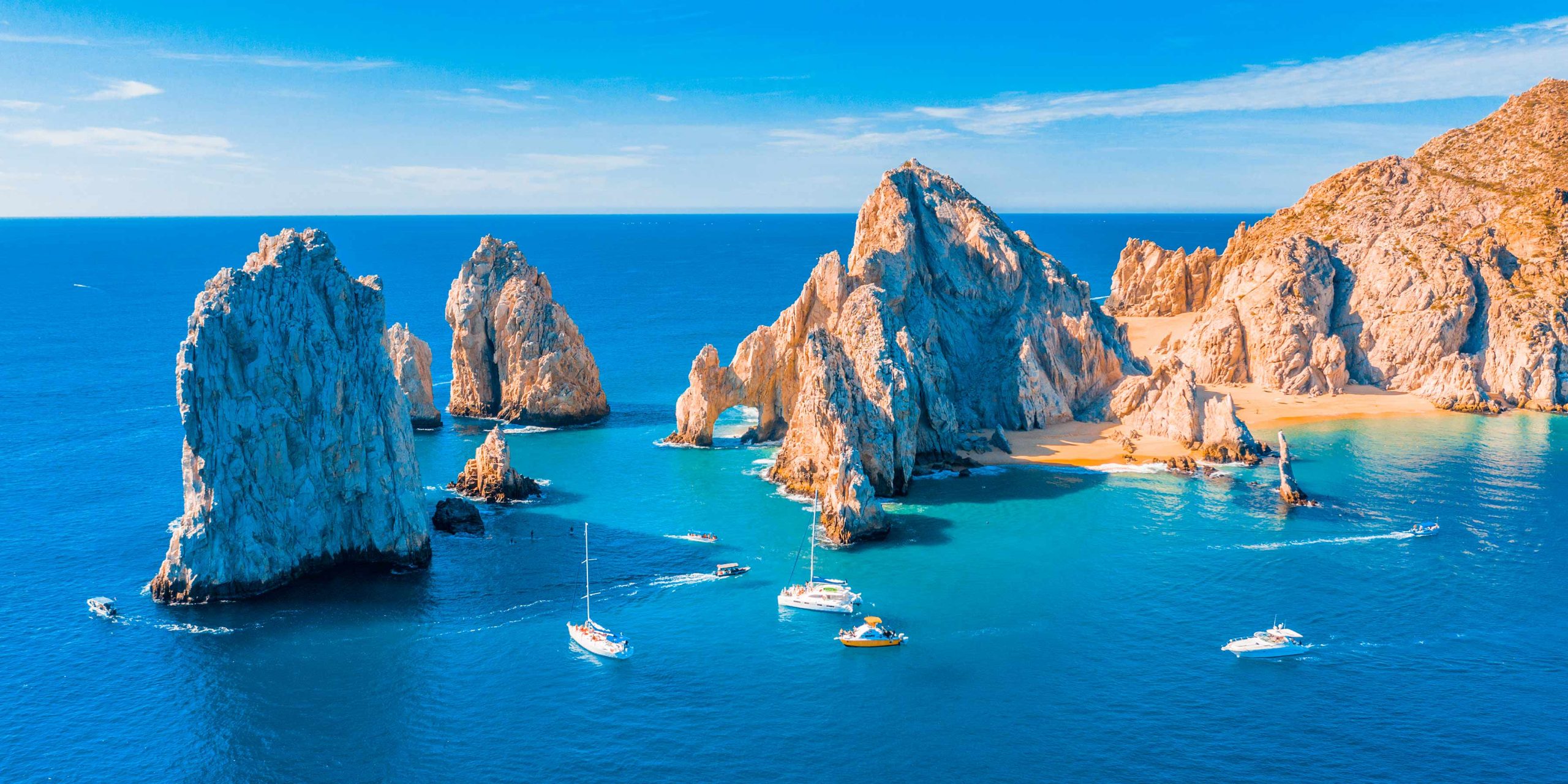- Overview
- Itinerary
- History
- Best Time
- Gallery
- FAQ
Los Cabos, where the desert meets the sea at the southern tip of the Baja California Peninsula, is a captivating destination that seamlessly blends natural beauty, vibrant culture, and luxurious amenities. Discover a world of contrasts, from the bustling energy of Cabo San Lucas to the tranquil charm of San José del Cabo. Indulge in world-class resorts, championship golf courses, and a vibrant nightlife scene. Explore the underwater world with snorkeling or diving excursions to the iconic El Arco, a natural rock formation where the Pacific Ocean meets the Sea of Cortez.
La Paz, the capital of Baja California Sur, offers a more laid-back and authentic experience. Stroll along the Malecón, a picturesque boardwalk lined with sculptures, shops, and restaurants. Immerse yourself in the city's rich history and culture, from the colonial architecture of the Cathedral of Our Lady of La Paz to the vibrant murals that adorn its streets. Embark on a whale-watching adventure to witness the majestic gray whales that migrate to the bay each winter, or explore the pristine beaches and islands of the Sea of Cortez.
Together, Los Cabos and La Paz offer a diverse and unforgettable experience, combining desert landscapes, vibrant marine life, rich history, and modern amenities. Whether you're seeking adventure, relaxation, or cultural immersion, this dynamic duo has something to captivate every traveler.
Mexico City and Los Cabos Excursions (8 Days)
Day 1 (Saturday)
- Arrival in Mexico City, hotel check-in.
- Welcome meeting.
Day 2 (Sunday)
- 7:00 to 8:45 am: Breakfast.
- Chapultepec Castle tour.
- Walk through the historic area.
- Return to the hotel and rest.
- Preparations for the evening dinner.
Day 3 (Monday)
- 7:00 to 8:45 am: Breakfast.
- Pyramid Tour and Guadalupe Shrine.
- Lunch at La Gruta.
- Return to the hotel for dinner.
Day 4 (Tuesday)
- 7:00 to 8:45 am: Breakfast.
- Fly to Los Cabos (SJC airport).
- Arrive at the hotel and check-in.
- Dinner at the hotel.
Day 5 (Wednesday)
- 7:00 to 9:00 am: Breakfast.
- Board bus at 9:30 am for Cabo San Lucas tour.
- Lunch in Cabo San Lucas.
- Stroll the main street for gift shopping.
- Return to the hotel for dinner.
Day 6 (Thursday)
- 7:00 to 9:00 am: Breakfast.
- Board bus at 9:30 am for Playa El Chileno tour.
- Dinner at El Merkado Food Market.
- Return to the hotel.
Day 7 (Friday)
- 7:00 to 9:00 am: Breakfast.
- Board bus at 9:30 am for a tour of San Jose del Cabo.
- Lunch in San Jose del Cabo.
- Return to the hotel for dinner.
Day 8 (Saturday)
- 7:00 to 9:00 am: Breakfast.
- Free day to spend at leisure.
- Dinner at the hotel.
Day 9 (Sunday)
- Breakfast and check-out from the hotel.
- Board ground transportation to the airport for the flight home.
-
Los Cabos:
- Pre-Hispanic Era: The Pericúes, an indigenous group of hunter-gatherers, were the first known inhabitants of the Los Cabos region. Their cave paintings and rock art offer glimpses into their ancient way of life.
- Spanish Exploration: In 1535, Spanish explorer Hernán Cortés arrived in the area, drawn by tales of pearls and riches. However, his attempts to establish a permanent settlement were unsuccessful due to harsh conditions and conflicts with the native population.
- Missionary Era: Jesuit missionaries arrived in the 18th century, establishing missions and introducing Christianity to the region. Their influence can still be seen in the architecture and cultural traditions of Los Cabos.
- Fishing and Mining: For centuries, Los Cabos was primarily a fishing and mining community. The discovery of pearls in the Sea of Cortez attracted fortune seekers, while the rich marine life sustained local fishermen.
- Tourism Boom: In the 20th century, Los Cabos experienced a dramatic transformation as tourism began to flourish. The construction of luxury resorts, golf courses, and marinas attracted visitors from around the world, transforming the region into a world-renowned destination.
La Paz:
- Pre-Hispanic Era: The Guaycura and Pericú indigenous groups inhabited the La Paz region for centuries before the arrival of the Spanish. They lived in small communities, relying on fishing and gathering for sustenance.
- Spanish Settlement: In 1535, Hernán Cortés established the first Spanish settlement in the area, named La Paz. However, it was abandoned due to harsh conditions and conflicts with the native population.
- Pearl Capital: In the 17th century, La Paz became a major center for pearl diving, attracting fortune seekers from around the world. The city's wealth and prosperity grew, leading to the construction of grand colonial buildings and churches.
- Capital of Baja California Sur: In 1829, La Paz was designated the capital of the newly formed territory of Baja California Sur. The city continued to grow and develop, becoming a center for trade, commerce, and government.
- Modern Metropolis: Today, La Paz is a vibrant and cosmopolitan city, offering a unique blend of history, culture, and natural beauty. It's a popular destination for tourists seeking a more authentic and laid-back Mexican experience.
Together, the histories of Los Cabos and La Paz offer a fascinating glimpse into the rich and diverse heritage of the Baja California Peninsula. From ancient indigenous cultures to Spanish colonial influence and modern development, this region's past is as captivating as its stunning landscapes and vibrant marine life.
Best Time to Visit Los Cabos & La Paz
Los Cabos and La Paz enjoy a warm, desert climate year-round, making them ideal destinations for sun-seekers and outdoor enthusiasts. However, certain times of year offer distinct advantages depending on your preferences and interests.
Los Cabos:
- October to May: This is the high season, with warm days, cool nights, and very little rainfall. It's the perfect time for beach activities, water sports, golf, and whale watching. However, expect larger crowds and higher prices during this period, especially during holidays and school breaks.
- June to September: The summer months bring higher temperatures and humidity, but they are also the best time to find deals on accommodations and activities. If you don't mind the heat, this can be a great time to visit and enjoy the region's vibrant festivals and events.
La Paz:
- October to March: This is the most popular time to visit La Paz, as the weather is mild and pleasant, with average temperatures ranging from the mid-70s to low 80s Fahrenheit (24-28 degrees Celsius). It's the perfect time for outdoor activities like hiking, kayaking, and snorkeling.
- April to September: The summer months bring warmer temperatures, but they are also the best time to witness the majestic gray whales that migrate to the bay. This is also the low season, so you can expect fewer crowds and more affordable prices.
Special Considerations:
- Hurricane Season: The Pacific hurricane season runs from May 15th to November 30th, with the highest risk of storms occurring from August to October. While hurricanes are relatively rare in Los Cabos and La Paz, it's always a good idea to check the weather forecast before you travel and consider purchasing travel insurance.
No matter when you choose to visit, Los Cabos and La Paz promise an unforgettable experience filled with sunshine, adventure, and natural beauty.
Los Cabos is served by the Los Cabos International Airport (SJD), which offers numerous domestic and international flights. La Paz is accessible via the La Paz International Airport (LAP), with regular flights from major cities in Mexico. Both destinations are also reachable by bus or car from other parts of Baja California Sur.
In Los Cabos, don't miss the iconic El Arco rock formation, the stunning beaches of Cabo San Lucas and San José del Cabo, and the vibrant nightlife scene. In La Paz, explore the Malecón boardwalk, the historic Cathedral of Our Lady of La Paz, and the beautiful beaches and islands of the Sea of Cortez.
In Los Cabos, you can go whale watching, swim with whale sharks, or take a camel ride through the desert. In La Paz, you can snorkel with sea lions, kayak in the Espiritu Santo Island Biosphere Reserve, or enjoy a sunset cruise on the Sea of Cortez.







